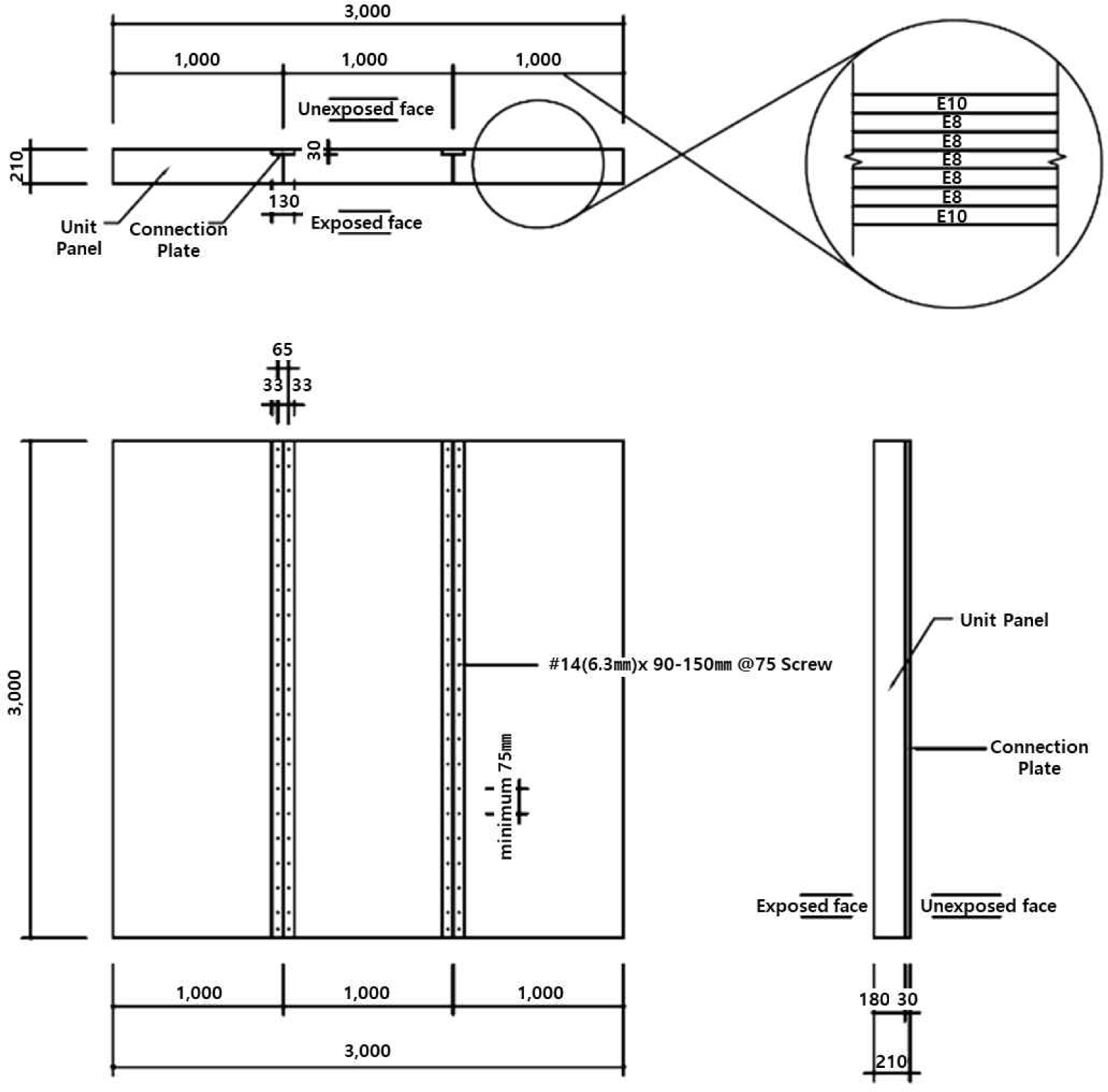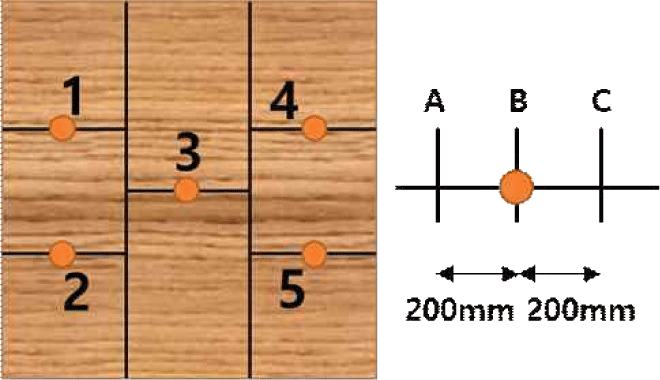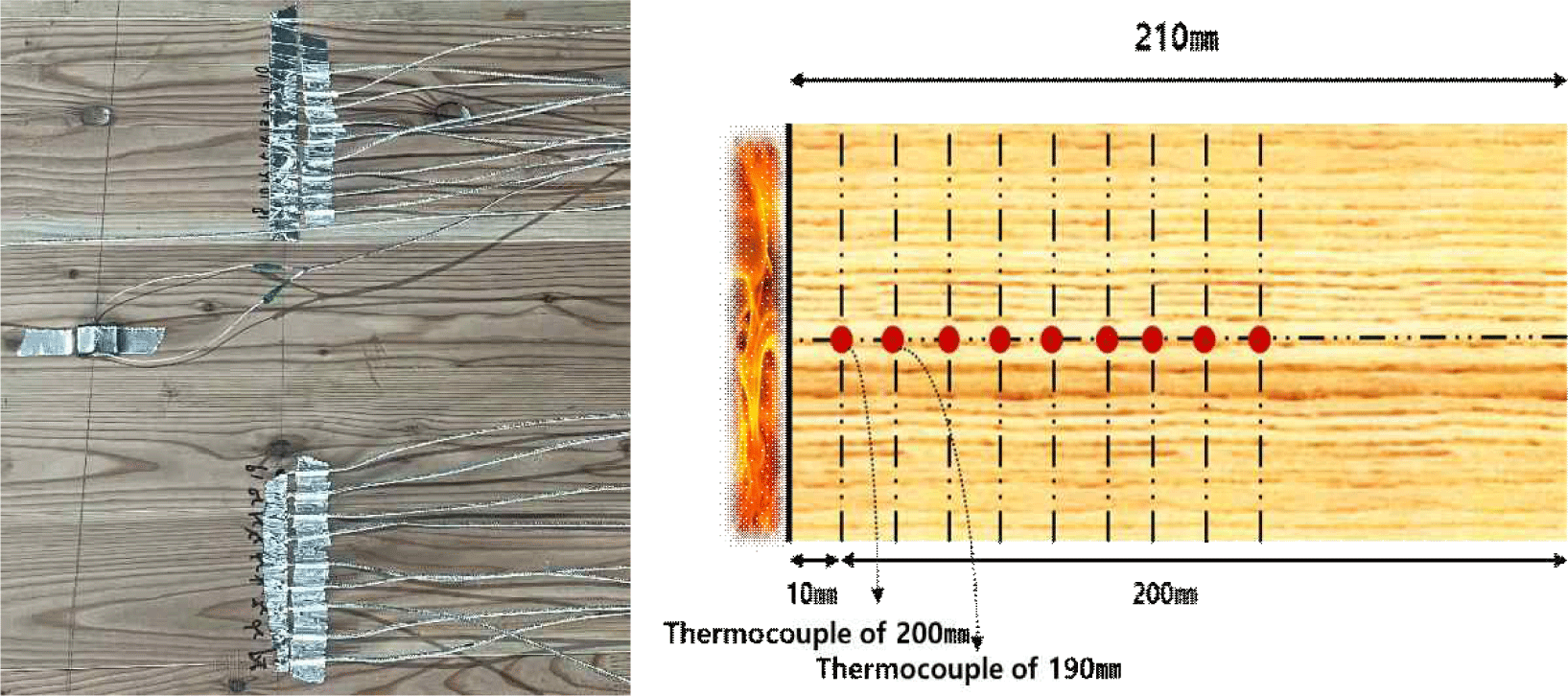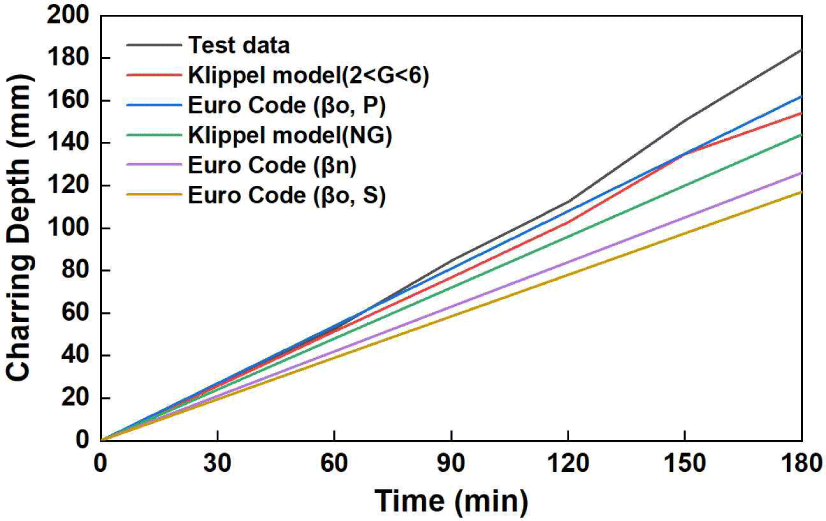1. INTRODUCTION
To avert the collapse of buildings and safeguard human life in the event of a fire, countries worldwide have instituted mandatory fire safety standards, encompassing fire resistance requirements, for buildings exceeding a specified size. In South Korea, a similar stipulation can be found in construction codes, which mandate the use of fire-resistant materials in structural components of buildings (An et al., 2023). Fire-resistant structures refer to structural components capable of maintaining their structural performance for a certain period of time, even under conditions of high temperature during a fire. The primary structural elements employed in timber frame construction must be engineered to ensure fire resistance (Eom et al., 2019; Kwon, 2010).
Timber structure buildings are characterized by a very short time to reach high temperature, with the peak of a fire occurring within approximately 10 minutes after ignition. Consequently, they are frequently perceived as structures susceptible to fire. However, wood possesses a thermal conductivity that is approximately 350 times lower than that of steel, as well as the advantage of maintaining high structural reusability even after a fire (Glass and Zelinka, 2010). Furthermore, Timber buildings have garnered attention as eco-friendly structures due to their substantial carbon storage capacity and the substitution effect they produce. When domestic wood is used, these systems are also effective in reducing embodied carbon, thereby facilitating carbon neutrality (Jeon and Kim, 2022).
Structural timber members are mainly classified into glued-laminated timber (GLT), which is utilized for the construction of columns and beams, and cross-laminated timber (CLT), which is employed for the fabrication of walls and floors. In the context of fire-resistant designs for such structures, the evaluation of performance is informed by the study of charring properties, such as charring depth and rate. Notably, the depth of the char layer plays a pivotal role in certification standards for domestic fire-resistant structures (An et al., 2023; Choi et al., 2024).
In this regard, Dietenberger et al. (2021) have presented the pyrolysis process that occurs when wood is exposed to high temperatures within a temperature range. At temperatures below 100°C, the strength of wood decreases due to dehydration, entering the “unburned wood“ stage. Between 100°C and 200°C, a process of chemical bond rupture occurs, resulting in the emission of non-combustible gases, including steam, acetic acid, and formic acid, as the charring process gradually advances. Pyrolysis commences at approximately 120°C, the charring process accelerates rapidly at temperatures above 200°C, and combustible volatile gases are generated at temperatures above 300°C, forming a char layer (An et al., 2023; Dietenberger et al., 2021). The fire-resistant design of wood uses these pyrolysis and charring behaviors as crucial basic data.
CLT reduces deformation such as warping, shrinkage, and cracking through lamination and bonding in orthogonal directions, thereby ensuring a high degree of structural stability (Hosseini et al., 2025). The processes of pre-manufacturing and processing are executed at the factory, thereby facilitating streamlined construction and shorter construction periods. Furthermore, the low thermal conductivity of the material offers distinct advantages in terms of insulation performance and energy efficiency. Additionally, its weight is approximately one-fifth that of reinforced concrete, which is advantageous for ensuring seismic performance (Hwang et al., 2024; Yoo and Lee, 2019).
Meanwhile, the relaxation of size restrictions on timber structures in domestic building codes has enabled the incorporation of wooden components in mid- and high-rise buildings, thereby catalyzing a substantial surge in the application of timber members. Consequently, the necessity of ensuring fire resistance has also increased considerably. While standard fire-resistant structures for domestically produced GLT have been established, standard fire-resistant structures for CLT are not yet in place, and the database (DB) for this purpose is also inadequate.
Therefore, this study aims to establish a practical DB by conducting fire resistance performance tests on CLT using Japanese larch (L. kaempferi) in Korea and to test the fire resistance behavior and charring properties by measuring char depth and temperature changes during a fire.
2. MATERIALS and METHODS
This fire resistance test was conducted to verify the fire resistance performance over time and compare the charring properties of CLT wall panels made from Japanese larch (L. kaempferi) in Korea. Tests were performed at 1 hour, 1.5 hours, 2 hours, 2.5 hours, and 3 hours. The specimens were structural laminated panels made solely from domestically sourced L. kaempferi timber members, without any dry-type fire-resistant board cladding materials such as fire-resistant gypsum boards, studs, runners, or infill materials. Furthermore, to eliminate variables related to specimen wall thickness, the thickness and dimensions of the wall specimens corresponding to the 1-hour to 3-hour test periods were consistently manufactured. Thermocouples for measuring the internal temperature of the specimens were installed as shown in Table 1 below, taking into account the expected char depth over time. The fire resistance test for vertical non-load-bearing walls was conducted using a single-face heating method, in which the entire surface was exposed to heat. The specimen was installed in a specimen-holding frame and subjected to the fire resistance test within a vertical furnace. The application of uniform heat to the specimen’s heated surface was achieved through the strategic placement of a 4 × 4 burner array within the furnace, ensuring homogeneous distribution. The system consisted of intake and exhaust passages for circulating air consumed during combustion, along with air dampers. The temperature inside the furnace was determined using the standard time-heating temperature curve specified in KS F 2257-1 (Fire Resistance Test Methods for Building Materials - General Requirements). Thermocouples installed within the specimen and on its non-heated surface measured the changes in temperature of the internal furnace over time, at different depths within the specimen, and on the back side (non-heated surface) of the specimen.
In order to evaluate the fire resistance performance of the CLT wall panel, a specimen was constructed with dimensions of 3,000 mm in width and 3,000 mm in height, which is the standard size for typical wall specimens. The specimens were fabricated with a thickness of 210 mm, consisting of seven layers of 30 mm, orthogonally laminated using polyurethane resin adhesive (PUR) and phenol-resorcinol-formaldehyde resin adhesive (PRF). All specimens were manufactured with the same thickness. The PUR and PRF adhesives used for laminate bonding were TU-541 and D-402 (Oshika, Tokyo, Japan), respectively, which were applied at a fixed rate of 230 g/m2 during fabrication.
The specimen comprised three unit panels measuring 1,000 mm in width, 3,000 mm in height, and 210 mm in thickness, along with two connecting plates measuring 130 mm in width, 3,000 mm in height, and 30 mm in thickness. These were affixed to the non-heated surface using screw bolts (Fig. 1). The connecting panels in this study were fabricated from L. kaempferi, the same material used in the specimen. These panels were positioned on the non-heated side of the specimen to mitigate any potential influence on the fire resistance test results. Screw bolts with washers and hex heads (T1490, T14120, T14150) were utilized. In order to avert direct exposure of the screw bolts to the heated surface due to the effects of the fire resistance test, bolt lengths were varied during installation based on the fire exposure time. The screw bolts were spaced at 150 mm intervals, arranged in two rows of 20 bolts each, totaling 80 bolts per specimen. A total of five wall specimens were prepared. Both the laminated wood and the connecting panels were made from domestically sourced L. kaempferi. The wood grades were E10 for the outermost layer of the 7-ply laminated wood and E8 for the inner layers (Fig. 1). The fabricated specimens had an average density of approximately 0.55 g/cm3 and an average moisture content of 9%.
The char depth of the CLT wall panel specimen was measured by cutting it perpendicular to the wall section from the rear side toward the heated surface and subsequently measuring the char depth. The char depth of structural laminated panels is measured using the formula below, as the fire resistance test is conducted in a vertical heating furnace with single-sided heating.
c: char depth (mm), t0: thickness of specimen before fire resistance test (mm), t0′: thickness of specimen after fire resistance test (mm).
Since the thickness (t0) of the specimen before testing was the same for all fabricated specimens at 210 mm, the char depth in the test was the measurement of the intact cross-sectional thickness (t0′;) subtracted from the total cross-sectional thickness of 210 mm.
The selection of measurement locations was determined by incising a cross-section at five points corresponding to the average and maximum temperature rise measurement locations on the non-heated surface, as specified in KS F 22578. As illustrated in Fig. 2, when the mean and maximum temperature rise measurement point was designated as B, measurements were also taken at points A and C, located 200 mm to the left and right of B, respectively. The char depth at these three points was calculated to determine the mean char depth per location. After measuring the char depth at five points across three locations per specimen, totaling 15 measurements (1–5, A–C), the average char depth per specimen was calculated.
Temperature measurements were taken inside the furnace chamber, on the non-heated (rear) surface, and along the test specimen to monitor temperature variations based on distance from the heating element, using thermocouples (K type, max temperature: 1,090°C, cable size: glass × Glass × Shield × 0.6 ⨐ × 3,000 mm, MAT'L: ceramic fiber dual structure + high shield). Temperature changes in each thermocouple were monitored over the heating time. In order to measure the temperature of the non-heated surface, thermocouples were utilized to measure the average and maximum temperature rise at five locations on the non-heated surface in accordance with KS F 2257-8. Considering the expected char depth, two sets of thermocouples were installed at varying depths within the test specimen. For the 1-hour fire resistance test specimen, seven thermocouples were installed in two sets (totaling 14) at 10 mm intervals from the thermocouple at 200 mm from the non-heated surface, which was 10 mm away from the heated surface, extending to a depth of 140 mm from the non-heated surface. For the 1.5-hour, 2-hour, and 2.5-hour specimens, the number of thermocouples increased by one every 10 mm, reaching 16, 18, and 20 thermocouples at depths of 130 mm, 120 mm, and 110 mm, respectively (Fig. 3). For the 3-hour fire exposure test specimen (CLTWP-NL-3.0h), 22 thermocouples were installed at varying intervals as the char rate was faster than the anticipated char depth from the previous test. The thermocouples were installed at a depth of 150 mm below the center of the test specimen, with two sets of thermocouples installed on each side according to the quantity corresponding to the fire exposure time. The spacing between each thermocouple at varying depths was set at 20 mm.
3. RESULTS and DISCUSSION
The mean char depth of the CLT wall specimens evaluated under non-standard conditions was measured as presented in Fig. 4. The average char depth and mean char rate are presented in Table 2. As the fire exposure time increased, both the average char depth and average char rate exhibited a consistent upward trend. The average char rate was approximately 0.99 mm/min, with a char depth of about 1 mm formed per minute. Unlike GLT, where the formation of a char layer reduced the char rate, the average char rate of CLT wall panels increased as the fire exposure time increased. After the test, the remaining CLT wall specimens showed that the residual layers were consistently formed from five layers down to one layer in each specimen. This demonstrated that no other variables affected the char depth of the CLT wall test specimen during the fire resistance test conducted in the furnace. Furthermore, unlike GLT where char depth and rate decrease due to char layer formation, the CLT wall specimen demonstrated that the role of the char layer was minimal, as both char rate and depth increased steadily over time. The results of the test conducted with specimens (CLTWR-NL-2.0h) fabricated with the PRF adhesive to compare adhesive performance showed that the average char rate and depth were reduced by approximately 37% compared to specimens (CLTWP-NL-2.0h) fabricated with the PUR adhesive under the same fire exposure time (Table 2). This finding suggested that PRF adhesive exhibited superior physical bonding strength compared to PUR adhesive when subjected to fire exposure, resulting in a comparatively diminished reduction in adhesive strength (Choi, 2025).
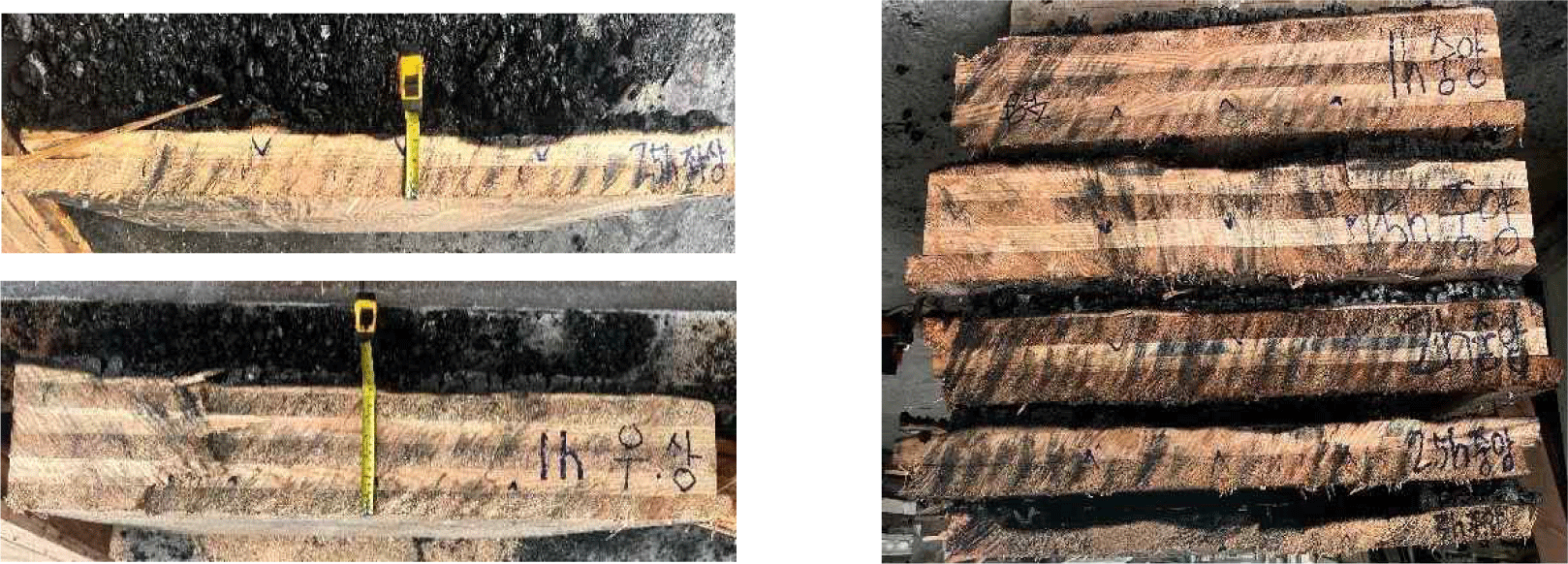
To compare char depth across test specimens and at different heights based on sampling locations, char depth was compared at five sampling locations: upper left, lower left, center, upper right, and lower right, and at three different heights: upper (upper left and upper right), center, and lower (lower left and lower right). As shown in Fig. 5(a), the char depth in the upper left region was somewhat higher for each specimen. However, since this did not deviate significantly from the average char depth, it was demonstrated that the char depth remained consistent regardless of the position of the specimen within the CLT. Furthermore, the comparison of char depth by height [Fig. 5(b)] showed that the char depth at the upper portion was somewhat lower than the average for most specimens. This may have been caused by the charring layers from specimens that fell off at the lower part of the furnace, which supplied additional fuel to the fire and potentially accelerated the charring process of the remaining specimens (Barber, 2018; Bøe et al., 2024; Miyamoto et al., 2021; Zelinka et al., 2019).
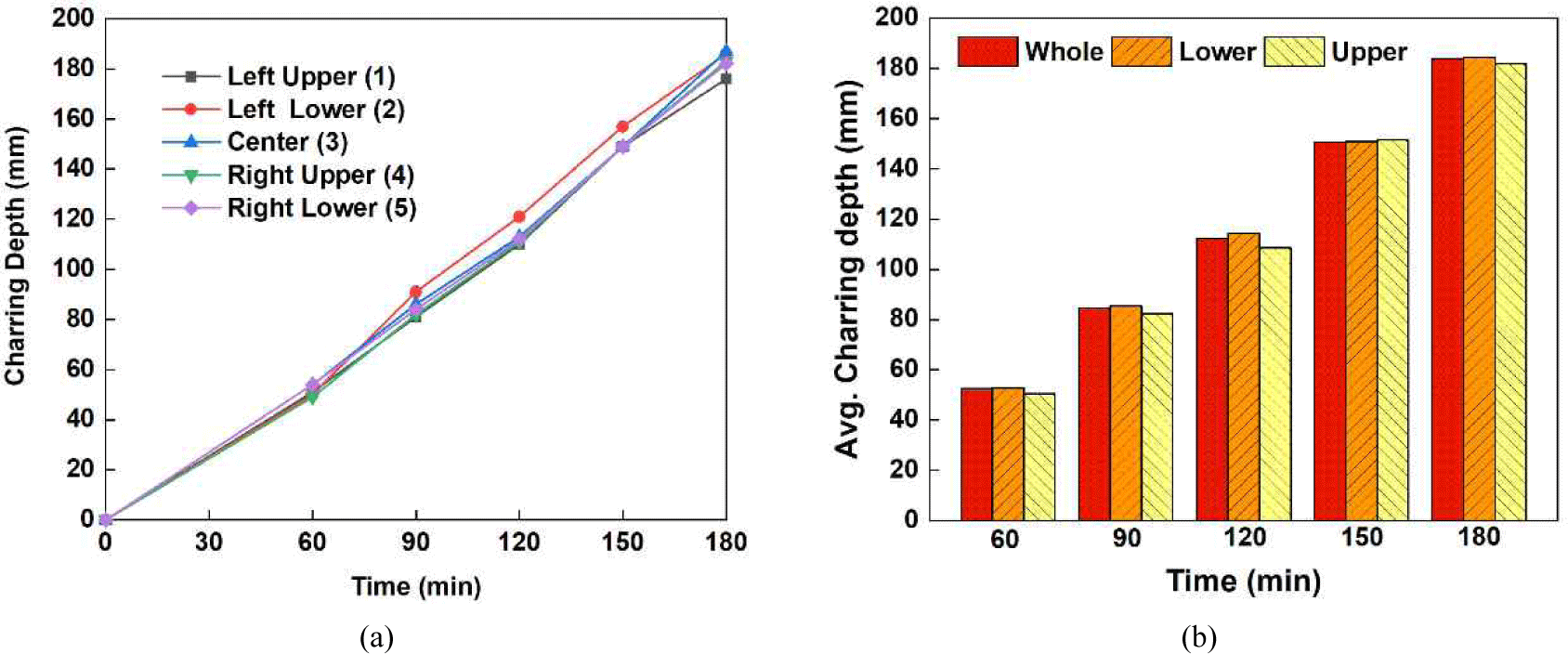
Fig. 6 shows the temperature change graph over time with the progression of the fire resistance test. In the fire resistance performance tests of the five specimens shown in Fig. 6(a), an increase in furnace temperature to over 1,000°C occurred rapidly in all cases approximately 45 minutes after the start of the test. This sudden increase in furnace temperature may have been caused by the detachment of the char layer from the CLT wall specimen, exposing new heated surfaces within the furnace. The detached char layer likely acted as additional fuel for the fire, leading to its reignition (Liu and Fischer, 2022; Miyamoto et al., 2021; Zelinka et al., 2019). Upon observing the temperature changes of the thermocouples installed inside each specimen [Fig. 6(b–f)], it was noted that the charring properties were similar to the measured char depth. As shown in Fig. 6(b), the temperature of the thermocouple installed at 200–180 mm on the CLTWP-NL-1.0h specimen (i.e., at locations 10–30 mm from the heated surface) was observed to exceed 1,000°C. This finding suggested that the specimen was exposed directly to fire at a proximity of approximately 30 mm from the heated surface. In addition, given that the temperature of the 170–160 mm thermocouple exceeded 300°C, a charring layer formed approximately 50 mm from the heated surface, which was consistent with the measured char depth of 52.6 mm. Furthermore, as shown in Fig. 6(c), the temperature of the 200–170 mm thermocouple installed on the CLTWP-NL-1.5h specimen exceeded 1,000°C, while the temperature of the 160–130 mm thermocouple increased above 300°C. This demonstrated that a char layer approximately 80 mm thick formed on the heated surface of the specimen, which was observed to be similar to the measured char depth of 84.6 mm. Fig. 6(c–f) showed that the char rate of the specimen was higher than the expected char rate. Despite the challenges posed by the inability to directly compare the measured char depth and trend, it was utilized as an indicator for understanding the delamination behavior of the char layer.
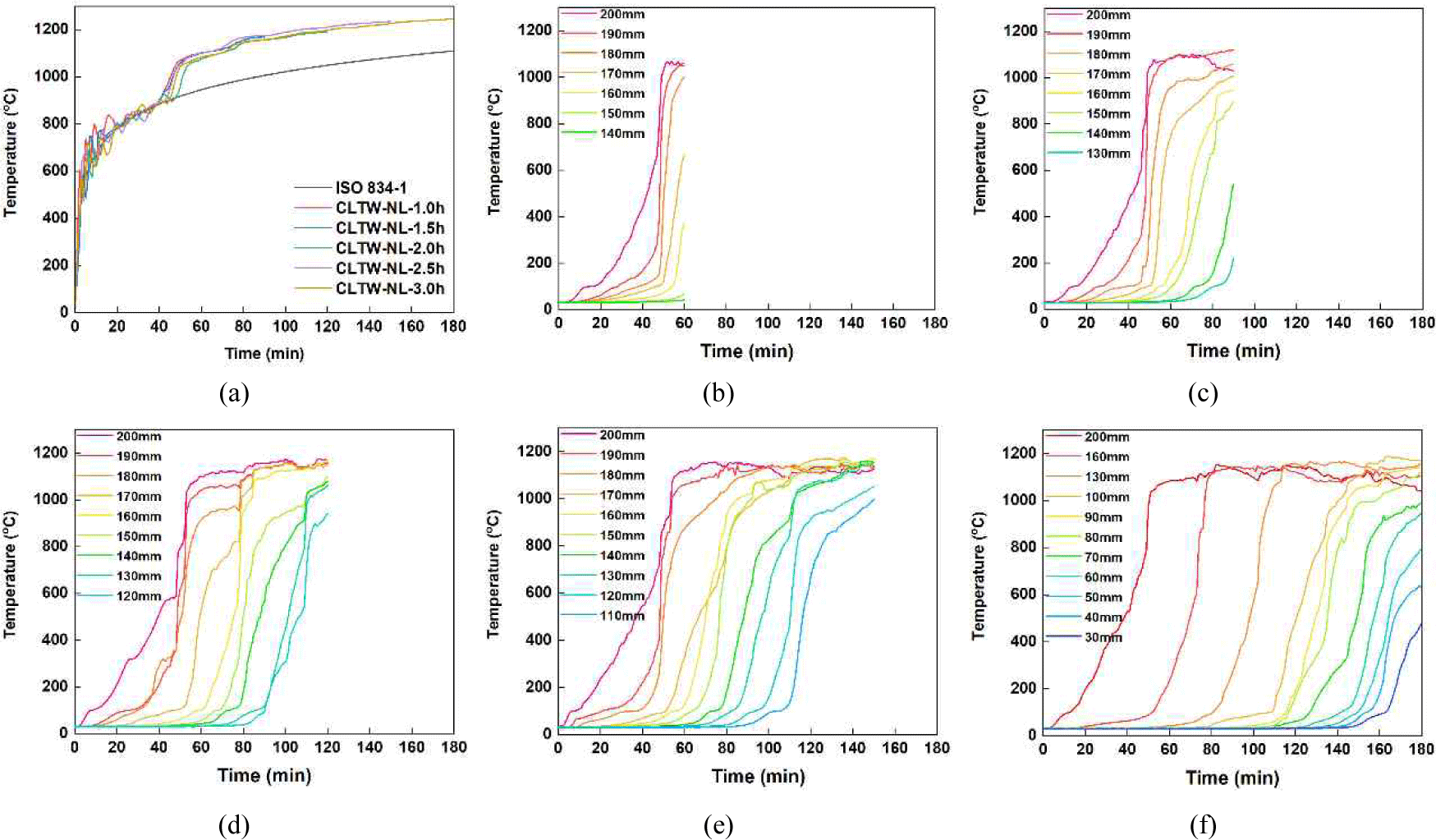
The internal temperature change graph of the CLTWP-NL-2.5h specimen revealed that three thermocouples grouped together exhibited temperature changes [Fig. 7(a)]. This was expected to be associated with the delamination of the CLT unit panels that comprised the specimen. The charring behavior of the test specimen during fire exposure would result in the delamination of the char layer from the adhesive interface in individual panel units due to the degradation of the wood adhesive bonding the unit panels (Liu and Fischer, 2022; Miyamoto et al., 2021). Measurements of the rear surface temperature taken on the non-heated side of the test specimens showed no temperature increase from the CLTWP-NL-1.0h specimen to the CLTWP-NL-2.5h specimen. However, a sharp temperature rise was observed starting around 150 minutes for the CLTWP-NL-3.0h specimen [Fig. 7(b)]. As a result of verifying the remaining specimens after the fire resistance test, it was observed that solely the CLTWP-NL-3.0h specimen, which retained a single layer of CLT, was impacted by the furnace temperature.
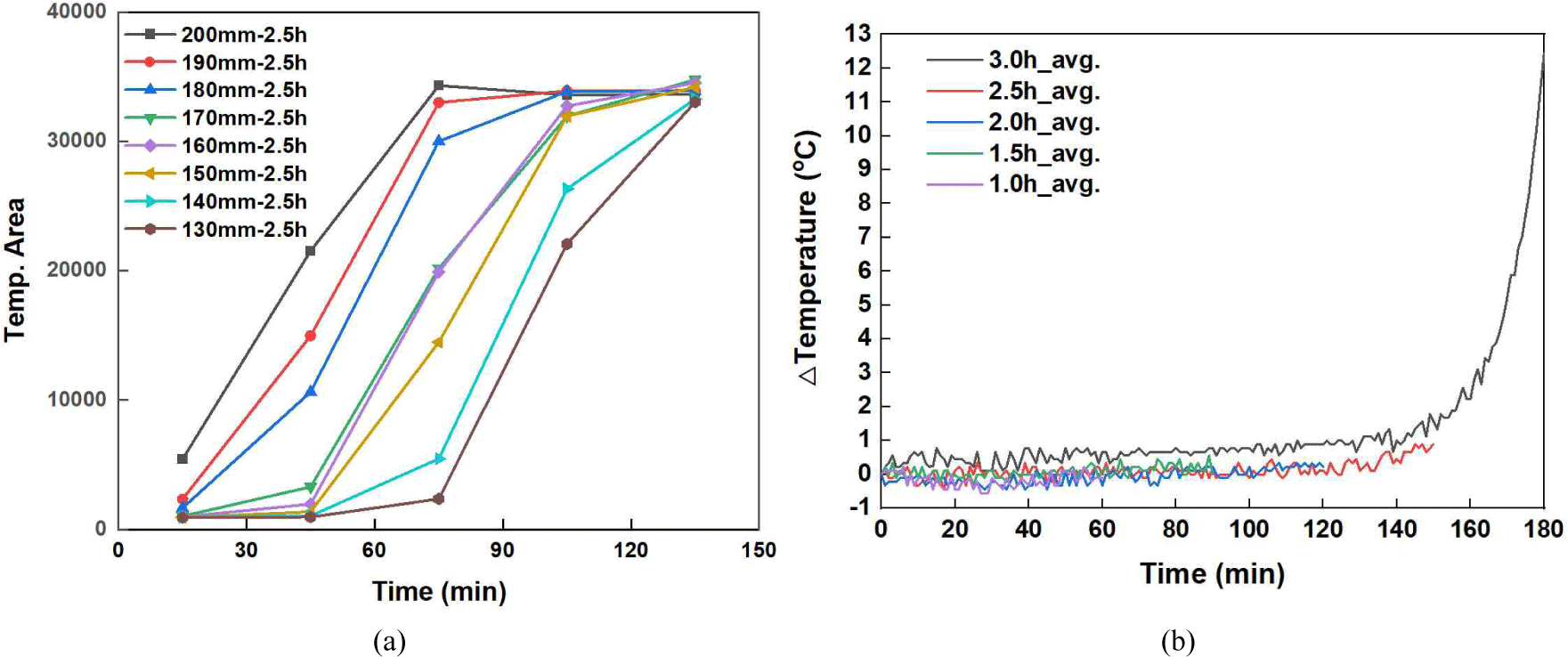
After the fire resistance test, the average char depth of the test specimens was calculated for each fire exposure time, and the average char depth and rate were presented as shown in the linear equation in Fig. 8(a). Considering the average char depth over time, the slope of the char rate was found to be approximately 0.99, indicating an average char rate of approximately 1 mm per minute. As the fire exposure time elapsed, the slope of the graph remained constant. Additionally, the charring properties were compared based on the influence of the PRF and PUR adhesives [Fig. 8(b)]. CLTWR-NL-2.0h was verified to exhibit an average char rate and depth approximately 37% lower than CLTWP-NL-2.0h. This finding suggested that PRF adhesive exhibited higher physical bonding strength than PUR adhesive when subjected to fire exposure, with a comparatively diminished reduction in adhesive strength (Choi, 2025).
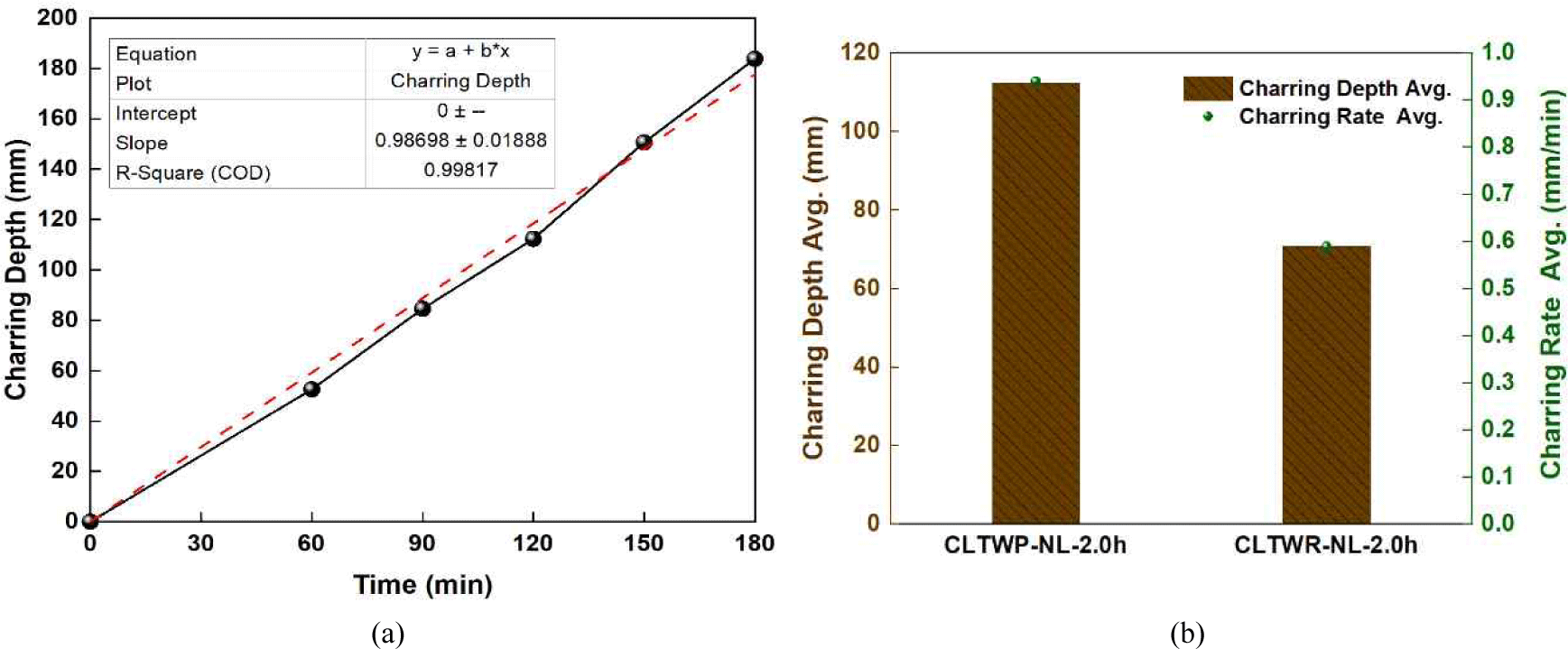
Unlike the charring behavior of GLT, where the formation of a char layer created a protective layer that gradually reduced the char rate, the charring behavior of CLT indicated that the protective role of the char layer was negligible. As confirmed previously, the charring behavior of the layers constituting the CLT wall specimen interacted during fire exposure. When the adhesive for engineering wood was exposed to fire, delamination of the char layer occurred, suggesting that this char accumulated within the furnace, causing an increase in furnace temperature [Fig. 9(a)]. This assertion was substantiated by the observation of a char layer of uniform thickness, which remained constant irrespective of the fire exposure time in Fig. 9(b). The fire resistance test results for specimens fabricated with the PUR and PRF adhesives, respectively, demonstrated varied patterns of char layer formation (Fig. 10). This indicated that the performance degradation of the PUR adhesive was greater than that of the PRF adhesive, which affected the formation of the char layer thickness.
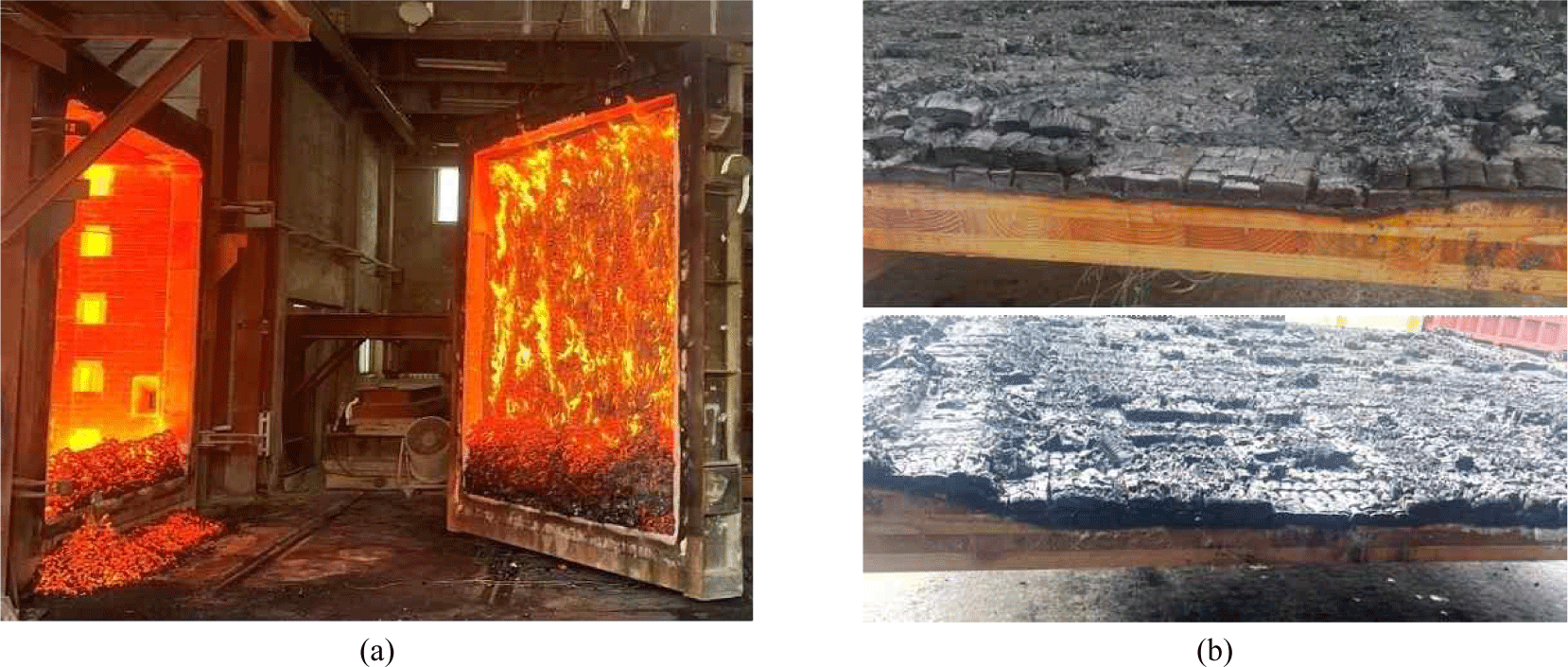

Eurocode 5 is a standard that addresses the fire design of timber structures, providing fundamental fire design guidelines for structural timber (European Committee for Standardization, 2004). Klippel and Schmid (2017) argued that Eurocode 5 exhibited limitations in reflecting the specific characteristics of CLT members, proposing a novel model based on the Eurocode 5 char rate model, incorporating the properties of adhesives for engineering wood (Wiesner and Bisby, 2019).
Different char rates were observed for CLT wall panels under fire test conditions, depending on the occurrence of delamination and the spacing between the adhesive interfaces of the constituent layers, considering the influence of the adhesive interface (Klippel and Schmid, 2017; Wiesner and Bisby, 2019). The char rate equation for this test was compared with the char rate equations for softwood and wall panels in the existing Eurocode 5, as well as the char rate equation proposed by Klippel (Fig. 11, Table 3). The char rate of the test results data showed a similar trend to the char rates of the panel model proposed by Klippel with a spacing of 2 mm or more and 6 mm or less [Klippel model (2 < G < 6)] and the wall panel model of Eurocode 5 [Eurocode (βo, P)] up to approximately 120 minutes. After 120 minutes, a difference in char rate began to occur. This suggested that the accelerated char rate after 120 minutes was due to the increased furnace temperature within the charring layer of the discarded test specimen.
| Specimen name |
Average char rate (mm/min) |
|---|---|
| Test data | 0.99 |
| Klippel model (2 < G < 6) | 0.86 |
| Euro code (βo, P) | 0.9 |
| Klippel model (NG) | 0.9 |
| Euro code (βn) | 0.7 |
| Euro code (βo, S) | 0.65 |
The char rates of the Eurocode 5 softwood model [Eurocode (βo, S)] and the model considering corner effects [Eurocode (βn)] for existing GLT showed significant differences from the char rates of the Klippel model (NG) for CLT without layer spacing, as well as the test data of this study.
In light of the numerous variables, including the lamination method, the wood species, and the adhesive properties of the specimens, it emerged as a necessity to establish fire design standards for timber structures that are compatible with Korean wood species.
4. CONCLUSIONS
-
The average char rate of CLT fabricated from domestically produced L. kaempferi was verified to be approximately 0.99 mm/min, thereby demonstrating the formation of a char depth of about 1 mm per minute.
-
The charring behavior of CLT wall panels resulted in the delamination of char layers at the interfaces between each layer due to the loss of adhesive interface functionality following high-temperature exposure. This resulted in a consistent char rate and depth with no discernible protective effect.
-
While the char layer retained a consistent thickness and remained intact, char layers that fell off due to thermal damage to the adhesive interface acted as an additional fuel source for the fire. This caused the temperature inside the test furnace to exceed the set value.
-
This study established the basis for constructing a fire resistance performance DB for structural timber using domestic tree species by presenting the quantitative char rate of CLT made from domestically grown L. kaempferi.
-
The findings of this study can serve as foundational data for standardizing fire-resistant structures in Korean timber buildings, comparing them with international fire-resistant design standards, and developing technologies to enhance adhesive performance under high-temperature exposure.

